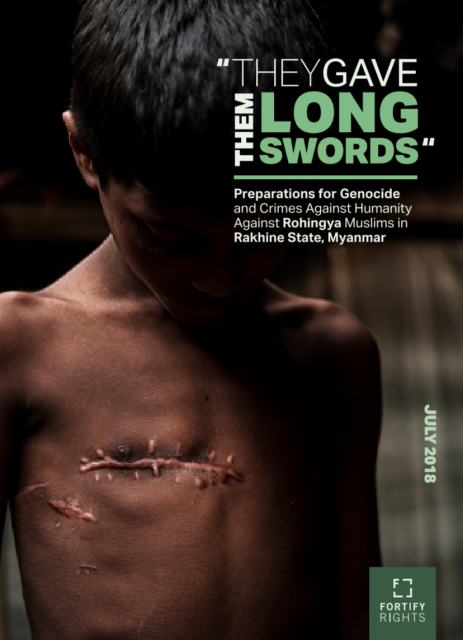They Gave Them Long Swords: Preparations for Genocide and Crimes Against Humanity Against Rohingya Muslims in Rakhine State, Myanmar


Summary
The United Nations Office on Genocide Prevention has found that genocide and crimes against humanity are “processes that take time to plan, coordinate and implement.” These crimes do not occur spontaneously or as isolated events; they require resources and decisions by people in positions of power.
The dominant narrative accepted internationally about what occurred in Myanmar’s northern Rakhine State in 2017 suggests that Rohingya militants attacked dozens of police outposts, instigating a spontaneous Myanmar Armyled crackdown against Rohingya civilians, forcibly displacing hundreds of thousands to Bangladesh.
This report documents and reveals a sinister subplot: Myanmar authorities made extensive and systematic preparations for the commission of mass atrocity crimes against indigenous Rohingya civilians during the weeks and months before Rohingya-militant attacks on August 25, 2017.
While the Myanmar authorities have subjected Rohingya to widespread and systematic human rights violations for decades, the Myanmar Army’s preparations for the most recent attacks on civilians in northern Rakhine State occurred between October 2016 and August 2017. On October 9, 2016, Rohingya men and boys armed mostly with sticks and knives attacked three police outposts, reportedly killing nine police and sparking a Myanmar Armyled attack on Rohingya civilians in approximately 40 villages in Maungdaw Township, displacing more than 94,000 civilians.
Following that wave of brutal violence, the international community failed to act, and Myanmar officialdom evidently took note: The military, administrative, and civilian authorities subsequently made a series of decisions and enacted several measures that contributed to the commission of the crime of genocide and crimes against humanity beginning August 25, 2017.
Specifically, this report documents how, between October 2016 and August 2017, Myanmar authorities:
• SYSTEMATICALLY “DISARMED” Rohingya civilians, confiscating household items that might be used as weapons or in self-defense.
• SYSTEMATICALLY TORE DOWN fencing and other structures around Rohingya homes, providing the military with a greater line-of-sight on civilians.
• TRAINED AND ARMED local non-Rohingya communities in northern Rakhine State.
• SUSPENDED HUMANITARIAN AID AND ACCESS TO ROHINGYA, systematically weakening the civilian population and removing monitors on the ground.
• ENFORCED A DISCRIMINATORY MUSLIM-ONLY CURFEW in northern Rakhine State and evacuated thousands of non-Rohingya citizens from the area.
• BUILT UP AN UNUSUALLY SIZABLE MILITARY PRESENCE, incommensurate with the threats at hand.
Taken together, these measures demonstrate a level of preparation not previously documented with respect to the Myanmar Army-led “clearance operations” in northern Rakhine State in 2016 and 2017. All of these measures fall within the United Nations Framework for Analysis of Atrocity Crimes for identifying “preparatory action” for genocide and crimes against humanity.
Moving from the preparations, almost immediately following the Arakan Rohingya Salvation Army’s (ARSA) attack on police outposts in Maungdaw, Rathedaung, and Buthidaung townships in northern Rakhine State during the early morning hours of August 25, Myanmar authorities descended on villages and activated non-Rohingya civilian squads, some of whom the authorities previously armed and/or trained. These civilian perpetrators were not vigilantes—they acted under the Myanmar military and police in razing hundreds of Rohingya villages throughout northern Rakhine State, brutally killing masses of unarmed Rohingya men, women, and children.
For its part, the Myanmar Army led massacres, systematically raped women and girls, and otherwise attacked Rohingya men, women, and children in hundreds of villages in all three townships of northern Rakhine State. The attacks continued for several weeks, forcing more than 700,000 Rohingya to escape to Bangladesh
There are reasonable grounds to believe that the crimes perpetrated in all three townships of northern Rakhine State constitute genocide and crimes against humanity. This report documents eight crimes against humanity—murder, extermination, rape, deportation or forcible transfer, torture, imprisonment, enforced disappearance, and persecution—as well as three acts of genocide committed with a special intent to destroy the Rohingya in whole or in part. Based on a comprehensive legal analysis, this report finds that Myanmar authorities may be liable for the crime of genocide and crimes against humanity.
Specifically, Fortify Rights identified 22 military and police officials responsible for the “clearance operations” in northern Rakhine State who should be criminally investigated for genocide and crimes against humanity. At the top of the list are Commander-in-Chief Senior General Min Aung Hlaing, Deputy Commander-in-Chief Vice-Senior General Soe Win, and the Joint-Chief of Staff General Mya Tun Oo.
At least 27 Myanmar Army battalions—including 22 Light Infantry Battalions and five Infantry Battalions—comprising up to 11,000 soldiers were involved in the attacks in northern Rakhine State beginning in August 2017, and at least three combat police battalions were also involved, comprising an estimated 900 police.
Fortify Rights conducted 254 interviews for this report in Myanmar and Bangladesh with Rohingya eyewitnesses and survivors, Bangladesh military officials, Myanmar military and police sources and analysts, members and former members of ARSA, international and local humanitarian aid workers, physicians, and others from October 2016 to June 2018.
Download full report HERE.

